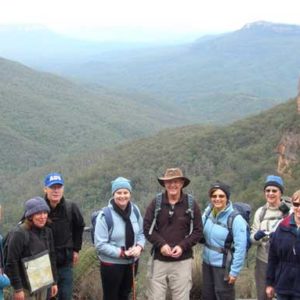Description
Bushwalking advice for bushwalkers by Konrad Lippmann – an avid Australian adventure Guide and team activities staff training facilitator. That incidently loves the power of PLAY.
Walk Safely Walk Softly
1* A good pair of worn-in bushwalking boots are excellent footwear, providing ankle stability and grip, however a pair of sturdy runners or sneakers are adequate. Each week the bushwalking program will concentrate on a particular aspect related to bushwalking. These include Walking Boots, Packs, Map Reading, Aboriginal art & culture, Exercise & Conditioning, Environmental Interpretation, Flora & Fauna identification.
2* Most bushwalking incidents involve ankle and knee injuries often caused by inadequate preparation and carelessness. This bushwalking course is programmed to gradually develop your fitness, and bushwalking capabilities as you progress over the term.
3* There is no such thing as “the wrong weather for bushwalking” , instead what is required is “the right gear for the conditions”. Remember, “Gear depends on weather and weather is anything but dependable”!
4* The ideal way to dress for bushwalking is to build your clothing “layer upon layer upon layer” In the mountains you can experience all 4 seasons in one day so be prepared, avoid heavy cotton fabrics such as denim jeans which lose warmth when wet and chafe against the skin. Don’t forget a cool hat to shade the sun.
5* Enjoy natures moods, as not all bushwalks fall on bright, sunny days. Without rain and winds we would not be able to appreciate swirling fogs, mist covered mountains, shimmering sandstones and blooming wildflowers. Don’t miss out on the opportunity walking in the rain, sometimes the most spectacular and memorable bushwalks are wet ones.
6* Anticipate unexpected changes in weather conditions, apply the scouts motto “Be Prepared”, by bringing rain gear, plenty of fluids and extra clothing. The weather we may see in Sydney (and forecasting) may not be the same as that where we will be walking that day.
7* Walk at an easy pace, that is the pace of the slowest member of your group. Walking steadily will conserve your energy and save your breath, particulary up hills. Walk steadily enjoying the scenery and you’ll get up just as quickly but enjoy it that much more.
8* It is important not to turn walking into an EGO TRIP! Getting there is most of the fun. “Walking flat out and arriving worn out, is not what its about”.
9* There is only one bushwalking leader in the group, so please in the interests of safety, take direction from your guide and all will be well.
10* Always let someone know where you are going and when you expect to return. Not all bushwalks run according to plan, problems can arise and getting home late is inevitable at some time or another. A social sip at a cafe` or pub is organised (after the bushwalk) to revive those weary bones.
11* Mentioning sustenance, Food (yes please)! A hearty healthy sandwich, some fruit packed into a unsquashable container and a minimum of 1.5l of water is all that is required. However walking increases hunger! Increase your social status by carrying high energy snacks such as muesli bars and chocolates which are great quick fixes. Many bushwalkers make their own mix of nuts, fruit and chocolate called ‘scroggin’. Gastronomical culinary delights are also admired (mmmm)
12* Rarely do we meet slithering snakes, however if fortunate to encounter any, stop and wait until they move on. Do not engage in conflict with these shy creatures. Be assured that snakes are deaf but do sense vibration and will happily retreat into the bush when they sense your approach.
13* The urge to go, it happens to us all. If there is a toilet nearby use it. If not start digging as feacal deposits should be buried 15cm (6”) and be at least 100m from any water course (bring your own tape measure). Toiletries (shovel + paper) provided.
14* Prevention is better than cure. With adequate equipment, clothing, food, fluid and listening to our bodies response, we will be able to avoid the most common environmental dangers of Hypothermia and Heat Exhaustion. Please notify your leader of any injury or sickness so they can deal with the situation.
15* Heat exhaustion is a condition to be particularly wary of in warm conditions and when walking strenuously. Symptoms include dizziness, fatigue, headache and tiredness. To avoid this drink plenty of fluids, up to 1 litre per hour, wear your cool hat and pace yourself. Out of breath – take it easy, slow down!
16* Hypothermia is a chilling of the body’s inner core, observations of symptoms include fatigue, lagging behind, dehydration, complaining of cold, blueness of lips. Ensure your fellow walkers are comfortable and enjoying the walk.
17* In the event of becoming “Geographically Embarrassed”, stay where you are. Blow three sharp whistle blasts every 20 seconds. Your guide will soon find you. “Have you been nice to your guide lately?”
18* Wilderness and the bush are environments we come to as visitors. It is natures domain and potential danger exist. But with adequate preparation and care, we will be able to “WALK SAFELY AND SOFTLY!”
Copyright Konrad Lippmann 1995-2023 and beyond.




